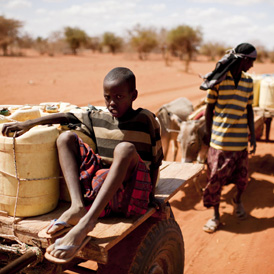Mogadishu: Caught between famine and war
Our Foreign Affairs Correspondent Jonathan Rugman travels into Mogadishu, to witness thousands of refugees who have risked everything crossing conflict zones to escape famine in the countryside.
Ahmed is eight months old and close to dying of hunger. He lies in the lap of his father, Abdi.
The pair have travelled for four perilous days to Mogadishu from the famine zone of south Somalia in what Abdi knows is a desperate race against time.
One-year-old twins, Avshir and Nasir, have just arrived in Badbaado. They are just two of the half a million children the UN says are seriously malnourished.
The boys’ mother says she walked to the capital because there’s nothing to live on outside. And she’s smiling, because she is lucky to have made it this far.
Over a thousand infants have been brought to the emergency nutrition centre since it opened just a few days ago. Their mothers are so busy trying to save their children’s lives that there’s barely time to grieve for the dead children they have left behind.
This feeding centre is just a few hundred metres from the frontline of Somalia’s seemingly never ending civil war, and these refugees – more than 23,000 people – have risked everything to cross it to escape from the famine zone in the countryside, where tens of thousands of people have already died.
Read more: A new generation dying in Somalia's famine

Journey through Mogadishu
Our journey began in the only safe mode of transport UN aid workers have – in the backs of armoured vehicles, manned by peacekeepers from Burundi, wielding machine guns.
Through the window – glimpses of the failed capital of a failed state. On the road out of Mogadishu we saw some of the 400,000 living in makeshift camps. First they fled the fighting. Now it’s famine and drought.
We reached the Badbaado camp where the UNICEF director for Somalia was dressed as if for battle. She can’t know how many in this teeming tent city are sympathisers with militants linked to Al Qaeda.
And everywhere there are men with guns. Militiamen from squabbling rival clans stand by, as Burundian forces keep watch in case food queues turn into riots.
We have to try, we can’t not try, it’s just too serious, Rosanne Chorlton, UNICEF
On our pickup truck we saw what looks like a child soldier. He says he’s 18, his cousin says he’s thirteen – the latest recruit to Somalia’s decades-old cycle of violence.
And if delivering aid amid Mogadishu’s ruins is difficult, imagine how hard it may prove where famine has been declared. Al Shabaab fighters have promised access. But who would believe them? To call the challenge daunting doesn’t describe it.
Rosanne Chorlton, the Somalia Director at UNICEF, said she’s hopeful the aid group can push further into Somalia in the coming days and weeks.
“We have to try, we can’t not try, it’s just too serious,” she told me.
And if proof was needed of just how serious it is, there are little boys like Saad aged 7, listless in his mother’s arms.
She told me the Islamists tried to stop them from reaching the capital, the fighters apparently in denial about what the UN calls the worst humanitarian disaster in the world.
Tens of thousands are seeking sanctuary in this camp. Yet what we’ve filmed cannot capture the scale of this crisis, with millions of Somalis beyond the reach of anyones help.
Follow Jonathan Rugman on Twitter: @Jrug
To donate to UNICEF's East Africa Children's Crisis Appeal please call 0800 037 9797 or visit www.unicef.org.uk